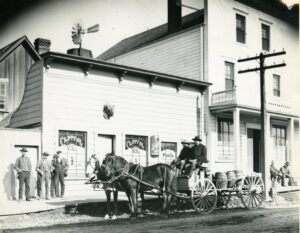William Wetherbee Gibbs, whose nickname was “Sam Slick,” operated a saloon out of the front of his Main Street home in the 1870s. Originally, built about 1866, Sam Slick’s Saloon was located just west of the Mendocino Hotel, in the space now occupied by its restaurant.

The Buffalo Saloon, c. 1886. Note the buffalo head over the door. Standing (L – R): Ed Hatch, Billy Grotz, and possibly Jacob Hanson. C. D. Sass and Martin L. Brinzing sit in a horse drawn delivery wagon with barrels of beer in the back. The Central Hotel (later known as the Mendocino Hotel) is the three-story building to the right. (Gift of Emery Escola, Emery Escola Collection, Kelley House Museum)
When Mr. Gibbs died, his widow, Petta Van Treat, leased the saloon in 1883 to Jacob Hanson, who named it the Buffalo Saloon. In his advertisements, he invited his friends and the general public to sample the best liquors and cigars.
A decade later, the saloon had been converted to a clothing store operated by J. L. Allen who sold a fine assortment of suits for boys, bicycles, aluminum hair ornaments, and jewelry.
But then, in 1897, the infamous Billy Grotz purchased the building and moved his Capitol O. K. Saloon here. Billy’s place was well known for its highly profitable slot machines and the “lewd women” who frequented it.
Hard times befell Mr. Grotz and he had to sell his business in 1902 to August Hofman, who advertised cigars and cold lunches of all kinds. Then came the watershed year of 1909, when Mendocino voted to become “dry” and saloons were banned. Ten years later, after World War I, it was used being used as an Army Surplus Store.
1932 was the year the old saloon came to an end. That was when Albert Brown, Mendocino’s electrical lighting champion, banker, and store owner, bought the Mendocino Hotel from John A. Silvia, and since the saloon building came with it, he hired John Burbeck and Jens Hansen to tear it down. The Beacon states that it had been unoccupied for several years, and its demolition would benefit nearby property owners by eliminating a fire hazard and lowering their insurance rates. No one seemed to mourn its loss.
That same summer, someone writing in the Beacon had a suggestion for the now empty site.
With a little imagination anyone can visualize a very attractive little park space in this enclosure. A protecting fence on the north side, a few good shrubs, possibly some hardy flowers, a grass plot in the center, some rustic benches conveniently placed, some paint on the adjoining buildings, and some manpower to back all of this. The result would more than justify the labor and expense involved and provide a pleasant spot in which to while away a little time.
And someone made it happen. Steve Jordon tells us that when he was growing up here in the 1950s, there was indeed a little park on this site with horseshoe pits, a place to throw balls around, and a fence with a gate and arbor along the Main Street sidewalk.
Then in 1967, Lauren Dennen, the Mendocino Hotel’s owner at the time, took the park concept to another level when he opened the beautiful “Village Garden Square” where the saloon once stood. From the hotel or from the street, you could walk in and be seated at the long, centrally located plank table that had as its base the old fire ladder truck of the Mendocino volunteer fire department. Music and live performances, such as the play “Under Milkwood,” were offered within its charming Victorian garden setting. Ten years later the garden space had been enclosed but continued as a restaurant.
Strangely, this building site continues to express its previous saloon and park incarnations. You can still find a bar in the Mendocino Hotel’s Garden Room, just as you could in the 1800s. And inside,, the trunks of the large Ficus trees living near the front door emerge through the floor from what appears to be actual soil.
The Kelley House Museum is currently showing “Jewelry For Doors – Vintage Doorknobs from the Larry Sawyer and Harriet Bye Collection.” Come see it Thursdays thru Sundays, 11 am to 3 pm. 45007 Albion Street, Mendocino. KelleyHouseMuseum.org. (707) 937-5791.